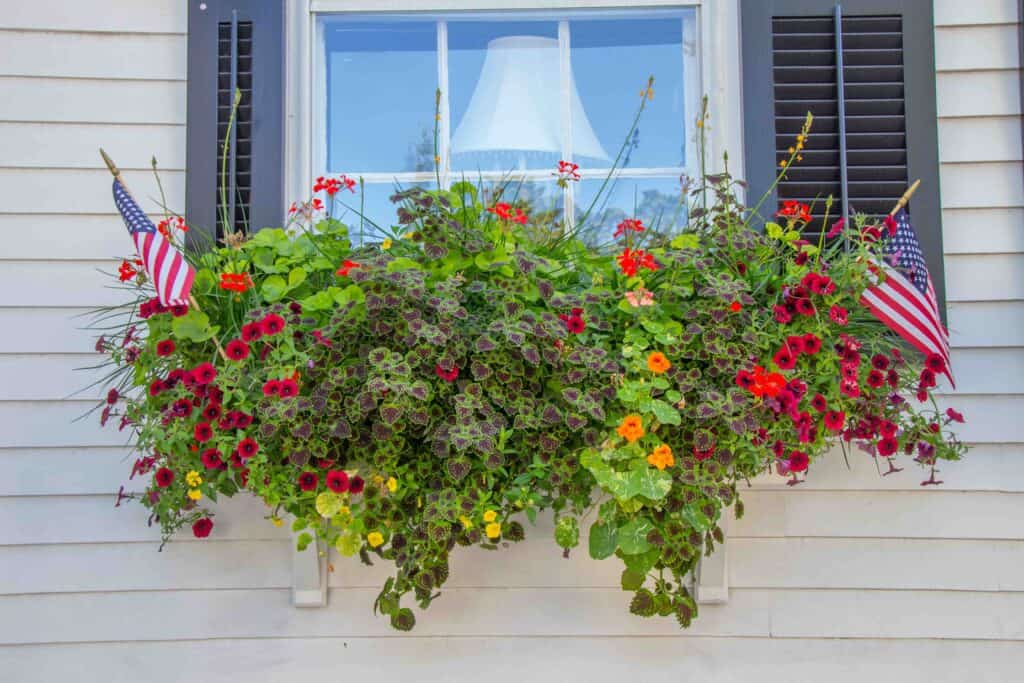Plant a window box this year and enjoy your tiny garden.
Window boxes are a delightful way to garden. They’re easy to install, simple to plant, and fun to care for. They don’t require endless hours of digging, bending and weeding to maintain. Best of all, window boxes make flowers and greenery a part of your home, growing in a place where you will see the plants often and enjoy them. If you’ve never gardened before, planting a window box or two will let you try your hand at growing plants on a small and very manageable scale. Mount window boxes on porch railings, windowsills, a garden shed or balcony.

Although most window boxes are more or less rectangular, your window box garden will look more natural if it contains plants of varying heights — taller plants in the back of the box, shorter plants in the middle, and low edging or trailing plants in the front to give the box a softer, less contrived look.
When planting window boxes, don’t line up your three sizes of plants in straight rows like little soldiers. For a more flowing, natural look, stagger the plants in the rows, placing some a bit farther back and others slightly forward. To bring visual movement to the box, vary plant heights from side to side across the box as well as front to back. Place taller plants at the back of the box, medium size plants in the middle ground, and smaller plants in the front. Including flowers that will spill over the front of the box adds charm.
Old-fashioned flowers and mixed color schemes bring a romantic look reminiscent of a cottage garden. Consider spicy-scented garden pinks, sweet William, johnny jump-ups, pansies, fuchsias, candytuft, nicotiana (flowering tobacco), cornflower, nasturtiums, calendula, primrose, French marigolds, Iceland poppy, and miniature roses.
For a romantic effect, you could include a flowering vine or two — morning glory or its night-blooming relative, moonflower, passionflowers, fragrant wisteria, honeysuckle, sweet peas or jasmine. Black-eyed Susan vine and canary creeper are other possibilities.
For a more formal look, design window boxes with plants neatly clipped and arranged in straight lines. A small evergreen centered in the back of the box adds height, and can be sheared in the shape of a neat cone or pyramid. Some plants for formal window boxes include dwarf boxwood, falsecypress (Chamaecyparis) and juniper. Upright flowering plants such as geraniums, tulips, daffodils, narcissus and impatiens also work well.

Window box containers should be at least 6 inches deep; 12 inches is even better. Wood is a classic material for window boxes; it’s a good insulator and protects plant roots from extreme temperatures better than plastic, clay or metal boxes.
Use an all-purpose potting mix, and check your boxes daily to see if they need watering. Regular watering is essential, as the small amount of soil in the boxes dries out quickly in summer weather. To keep the plants growing well, fertilize with an all-purpose liquid fertilizer beginning when the plants have been growing for several weeks. Follow the package directions.
Go over your window box plants regularly to pick off faded flowers and wilted leaves. Many-branched plants like impatiens need to be pinched back periodically to encourage bushier growth and lots of flowers. Then enjoy your tiny garden!












![Treat yourself to an unforgettable evening this Sunday, November 17th, at @sensagharbor 🍣🍸 Indulge in chef-curated courses featuring luxurious caviar, rich Wagyu beef, and perfectly paired wines from @paumanokvineyards. A night of indulgence and elegance awaits—don’t miss this exclusive culinary experience! [link in bio]](https://hamptonsrealestateshowcase.com/wp-content/uploads/sb-instagram-feed-images/467184544_1766493134164226_6024859026051554135_nfull.webp)
![Homeowners are faced with the daunting task of choosing the right kitchen design — one that will remain timeless for both entertaining and day-to-day functionality. With a focus on luxury, clients are increasingly leaning towards clean, modern aesthetics but are hesitant to embrace a fully contemporary look. [link in bio]](https://hamptonsrealestateshowcase.com/wp-content/uploads/sb-instagram-feed-images/467244043_1082221510295882_2208387561574057218_nfull.webp)
![Experience the epitome of coastal country living in this newly constructed, quality craftsmanship waterfront home on James Creek, leading to Peconic Bay. With 80± ft. of prime waterfront, 4060 Ole Jule Lane showcases thoughtfully landscaped grounds, a bluestone patio, outdoor shower, and a refreshing saltwater pool. Represented by @nataliealewis of @coldwellbanker. [link in bio]](https://hamptonsrealestateshowcase.com/wp-content/uploads/sb-instagram-feed-images/467188671_18474458155030135_7164624532118372206_nfull.webp)
![Welcome to 122 Mill Pond Lane, an impeccably conceived and meticulously maintained residence in a dramatic west-facing setting on Mill Pond. Throughout the home are thoughtfully considered elements that reinforce the home’s clean, modern sensibility. Represented by @kraelyllahamptons of @hamptonsrealestate. [link in bio]](https://hamptonsrealestateshowcase.com/wp-content/uploads/sb-instagram-feed-images/466787127_18474263443030135_2753720635361764689_nfull.webp)

![Perched atop the dunes at Louse Point sits 2 picturesque homes at 88 & 86 Louse Point Road, both perfect for enjoying all seasons that East Hampton has to offer. Each thoughtfully designed home maximizes the topography to allow seamless indoor/outdoor living and entertaining. Represented by @petrieteam of @compass. [link in bio]](https://hamptonsrealestateshowcase.com/wp-content/uploads/sb-instagram-feed-images/466619407_18473886082030135_7330054085188815713_nfull.jpg)
![Get cozy every Friday at Canoe Place Inn! 🍫🔥 Gather around the fire on our Garden Lawn for Fireside Fridays all season long, where evenings are warmed up with hot cider, hot chocolate, s’mores, and cocktails. Enjoy live acoustic music on select dates, and with your first drink, receive a complimentary s'mores kit! [link in bio]](https://hamptonsrealestateshowcase.com/wp-content/uploads/sb-instagram-feed-images/466374901_1761070534297706_6837753985329213061_nfull.jpg)
![Musical Superstar and Sag Harbor resident Billy Joel has listed his 26± acre Long Island estate for $50M. Assembled over time on adjoining parcels, the Centre Island compound features a 20,000± sq. ft. main home plus several additional structures—all with access to 2,000± ft. of private shoreline boasting a dock and a boat ramp. [link in bio]](https://hamptonsrealestateshowcase.com/wp-content/uploads/sb-instagram-feed-images/465973748_18473309701030135_6935355293028123088_nfull.jpg)
